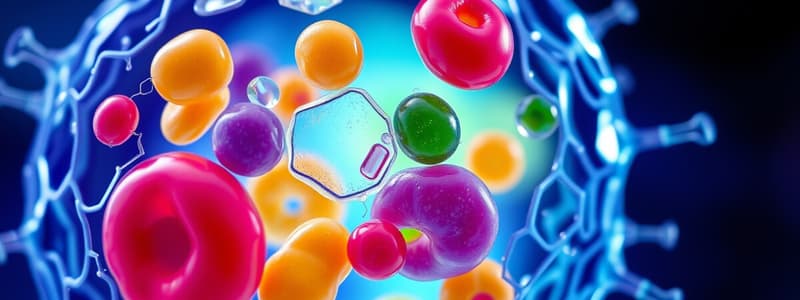Podcast
Questions and Answers
What is the primary function of mitochondria in a cell?
What is the primary function of mitochondria in a cell?
- Protein synthesis
- Storage of genetic material
- Modification of proteins
- Energy production (correct)
Which organelle is responsible for modifying, sorting, and packaging proteins?
Which organelle is responsible for modifying, sorting, and packaging proteins?
- Lysosomes
- Nucleus
- Golgi apparatus (correct)
- Ribosomes
What is the role of ribosomes in the cell?
What is the role of ribosomes in the cell?
- Energy production
- Detoxification
- Protein synthesis (correct)
- Cell division organization
Which structure is primarily involved in providing structural support to the cell?
Which structure is primarily involved in providing structural support to the cell?
What component of the cell membrane is primarily responsible for maintaining fluidity?
What component of the cell membrane is primarily responsible for maintaining fluidity?
Which type of endoplasmic reticulum is studded with ribosomes?
Which type of endoplasmic reticulum is studded with ribosomes?
Which of the following organelles contains digestive enzymes?
Which of the following organelles contains digestive enzymes?
In what way do carbohydrates on the cell membrane function?
In what way do carbohydrates on the cell membrane function?
What does the fluid mosaic model describe?
What does the fluid mosaic model describe?
Flashcards
Nucleus
Nucleus
Contains genetic material (DNA); controls cell activities and regulates gene expression.
Mitochondria
Mitochondria
Produces ATP through cellular respiration; involved in energy metabolism.
Ribosomes
Ribosomes
Sites of protein synthesis; can be free in the cytoplasm or attached to the rough ER.
Endoplasmic Reticulum (ER)
Endoplasmic Reticulum (ER)
Synthesizes proteins (rough ER) and lipids; detoxifies harmful substances (smooth ER).
Signup and view all the flashcards
Golgi Apparatus
Golgi Apparatus
Modifies, sorts, and packages proteins and lipids for secretion or delivery to other organelles.
Signup and view all the flashcards
Lysosomes
Lysosomes
Contains digestive enzymes that break down waste materials and cellular debris.
Signup and view all the flashcards
Peroxisomes
Peroxisomes
Involved in the breakdown of fatty acids and detoxification of harmful substances.
Signup and view all the flashcards
Cytoskeleton
Cytoskeleton
Provides structural support and shape to the cell; facilitates movement of organelles and cell division.
Signup and view all the flashcards
Phospholipid Bilayer
Phospholipid Bilayer
Composed of two layers of phospholipids with hydrophilic heads and hydrophobic tails.
Signup and view all the flashcardsStudy Notes
Organelles Functions
-
Nucleus
- Contains genetic material (DNA).
- Controls cell activities and regulates gene expression.
-
Mitochondria
- Powerhouse of the cell; produces ATP through cellular respiration.
- Involved in energy metabolism.
-
Ribosomes
- Sites of protein synthesis.
- Can be free in the cytoplasm or attached to the rough endoplasmic reticulum (ER).
-
Endoplasmic Reticulum (ER)
- Rough ER: Studded with ribosomes; synthesizes proteins.
- Smooth ER: Lacks ribosomes; synthesizes lipids and detoxifies harmful substances.
-
Golgi Apparatus
- Modifies, sorts, and packages proteins and lipids for secretion or delivery to other organelles.
-
Lysosomes
- Contains digestive enzymes that break down waste materials and cellular debris.
-
Peroxisomes
- Involved in the breakdown of fatty acids and detoxification of harmful substances.
-
Cytoskeleton
- Provides structural support and shape to the cell.
- Facilitates movement of organelles and cell division.
-
Centrioles
- Involved in cell division; helps organize the spindle fibers.
Cell Membrane Structure
-
Phospholipid Bilayer
- Composed of two layers of phospholipids with hydrophilic (water-attracting) heads and hydrophobic (water-repelling) tails.
- Forms a semi-permeable barrier that regulates the entrance and exit of substances.
-
Proteins
- Integral proteins span the membrane and function as channels or transporters.
- Peripheral proteins are located on the membrane's surface and are involved in signaling and structural support.
-
Carbohydrates
- Glycoproteins and glycolipids are involved in cell recognition and communication.
- Play a role in immune response and tissue formation.
-
Cholesterol
- Embedded within the phospholipid bilayer, it maintains membrane fluidity and stability.
-
Fluid Mosaic Model
- Describes the cell membrane as a dynamic structure with various proteins floating in or on the fluid lipid bilayer.
- Allows for flexibility and movement of components within the membrane.
Organelles Functions
-
Nucleus
- Houses DNA, the blueprint for genetic information.
- Controls cell activities and regulates gene expression.
-
Mitochondria
- Known as the powerhouse of the cell, responsible for producing ATP via cellular respiration.
- Plays a significant role in energy metabolism.
-
Ribosomes
- Integral for protein synthesis within the cell.
- Can exist free in the cytoplasm or attached to rough endoplasmic reticulum (ER).
-
Endoplasmic Reticulum (ER)
- Rough ER: Characterized by ribosomes on its surface; primarily synthesizes proteins.
- Smooth ER: Lacks ribosomes; involved in lipid synthesis and detoxifying harmful substances.
-
Golgi Apparatus
- Modifies, sorts, and packages proteins and lipids for secretion or distribution to other organelles.
-
Lysosomes
- Contains enzymes that digest waste materials and cellular debris, playing a vital role in cellular cleanup.
-
Peroxisomes
- Involved in breaking down fatty acids and detoxifying harmful substances, contributing to metabolic processes.
-
Cytoskeleton
- Offers structural support, maintaining cell shape.
- Aids in the movement of organelles and is essential for cell division.
-
Centrioles
- Play a crucial role in cell division by organizing spindle fibers.
Cell Membrane Structure
-
Phospholipid Bilayer
- Made of two layers of phospholipids with hydrophilic heads and hydrophobic tails.
- Creates a semi-permeable barrier that controls the movement of substances in and out of the cell.
-
Proteins
- Integral proteins span the membrane, acting as channels or transporters for molecules.
- Peripheral proteins, located on the membrane's surface, assist in signaling and provide structural support.
-
Carbohydrates
- Glycoproteins and glycolipids contribute to cell recognition and communication processes.
- Important for immune responses and tissue formation.
-
Cholesterol
- Embedded in the phospholipid bilayer, it helps to maintain the fluidity and stability of the membrane.
-
Fluid Mosaic Model
- Illustrates the cell membrane as a dynamic structure with proteins dispersed within the fluid lipid bilayer.
- Allows flexibility and movement of membrane components, facilitating various cellular processes.
Studying That Suits You
Use AI to generate personalized quizzes and flashcards to suit your learning preferences.




